1lumen selects and reviews products personally. We may earn affiliate commissions through our links, which help support our testing.
NEXTORCH Saint Torch 31 review

NEXTORCH Saint Torch 31 specifications
| Brand/model | NEXTORCH ST 31 |
|---|---|
| LED | 8*CREE XHP50.2 |
| Lumens | 20,000 lm |
| Beam intensity | 740m / 136,900 cd |
| Battery config. | Built-in 6* 21700 |
| Material | Aluminum |
| Modes | 4 |
| Blinkies | Strobe, SOS |
| Reflector | OP (orange peel) |
| Waterproof | IPX7, 1m waterproof |
| Review date | September 2021 |
Introduction:
It probably won’t surprise you to know that I have a spreadsheet of all the flashlights I own with their specs. This includes a chart with each light’s maximum brightness and throw. Very occasionally I get the opportunity to review a new light that means I need to extend one of the chart’s axes to accommodate a new Number One in my collection.
The NEXTORCH Saint Torch 31 is one such light. Twenty. Thousand. Lumens.
This may be less than the 40,000 lumen Acebeam X50 that Marco reviewed recently or some other lights from Acebeam or Imalent but it’s still a significant amount of light.. I was very keen to get my hands on it to review and there was definitely a big grin on my face when turning it on turbo for the first time.
This is my first NEXTORCH light, even though they have been around for 16 years and have produced everything from tactical, EDC, search and rescue, headlamps, and most recently LEP flashlights like the L10 Max.
The Saint Torch 31 is the brightest and biggest light available from NEXTORCH and as such, it commands a significant price. Saint Torch seems to be NEXTORCH’s high output search and rescue range of flashlights. NEXTORCH has the 11 and the 30 in the same series but these are both under 10,000 lumens. This 31 is a significant step up from these, with Nextorch fitting it with their latest technology.
This all sounds incredible on paper. Let’s see how the Saint Torch 31 (or ST31) does when it’s put through its paces.
Package quality.
My family are used to seeing delivery drivers turn up with flashlights and various electronic components. When I brought in a parcel weighing a few kg from the delivery driver, I was asked “what on earth have you ordered now?” and was met with looks of derision. My family would have seen my look of glee as I ripped off the packaging and saw the “Max output 20,000 lumens”.
The box the ST31 comes in is over a foot long and includes all the specs and details of the accessories.
Inside the cardboard box is the NEXTORCH Multi-function Carry Bag. This is made of thick nylon and is padded at the bottom. As well as the carry handle on the top there’s MOLLE attachments and loops for the shoulder strap. The ST31 fits in this easily, with room in the internal compartment for the accessories.
Included in the package, you get:
- NEXTORCH Saint Torch 31
- Multi-function Carry Bag
- Mains USB charger
- USB cable (A to C)
- 2-part seal cover (screws on the battery pack or the head if they’re being stored separately)
- Shoulder strap
- Handle mount
- Hex key (2.3mm, for the handle)
- Manual
- Protective plastic on the lens (take this off before turning on!)
The flashlight itself includes a battery pack, so NEXTORCH has provided everything you need to get started. The only thing not included is spare o-rings, though I rarely end up needing to use spares.
- The flashlight name
- Lanyard
- O-rings
- Warranty card
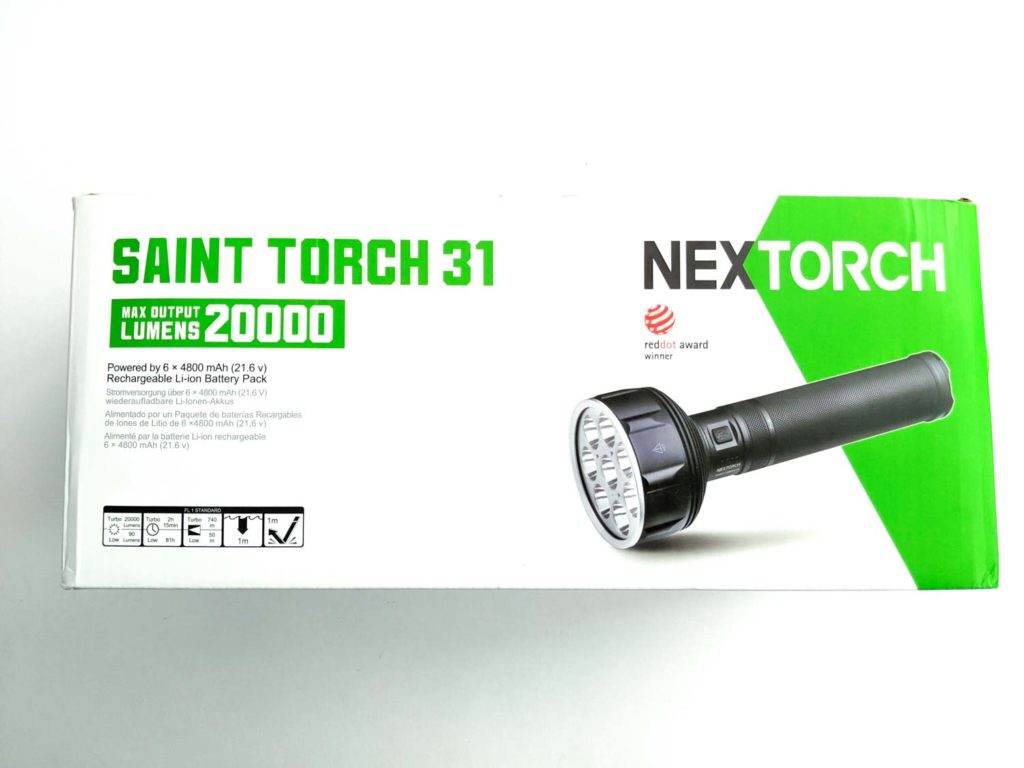
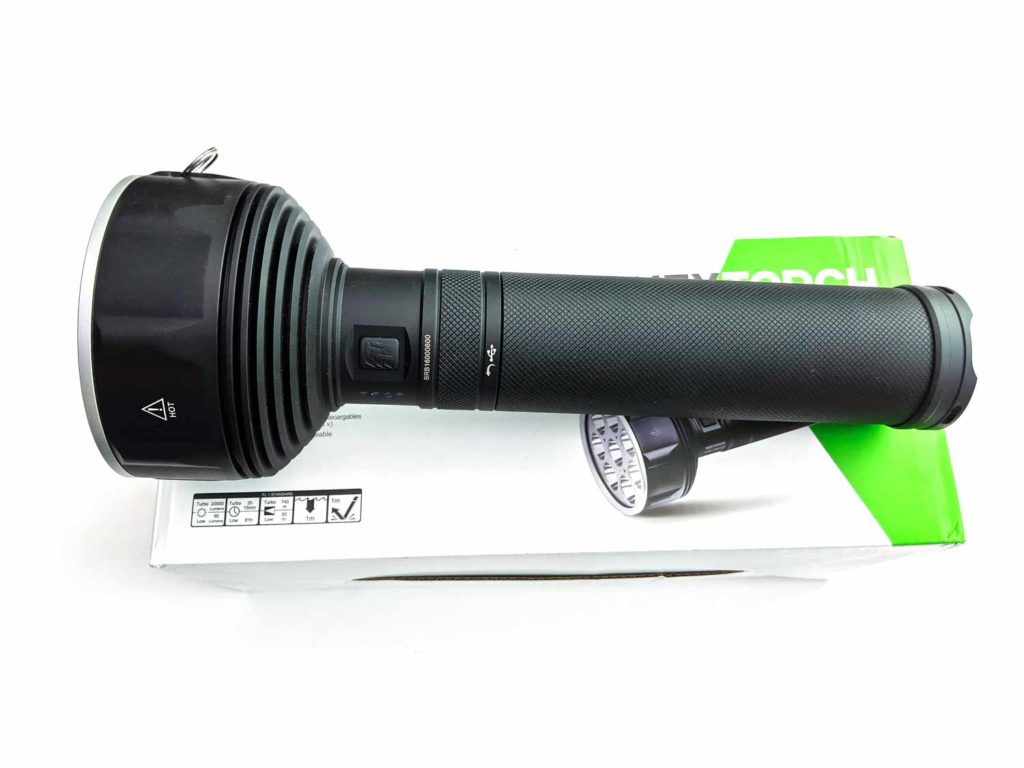
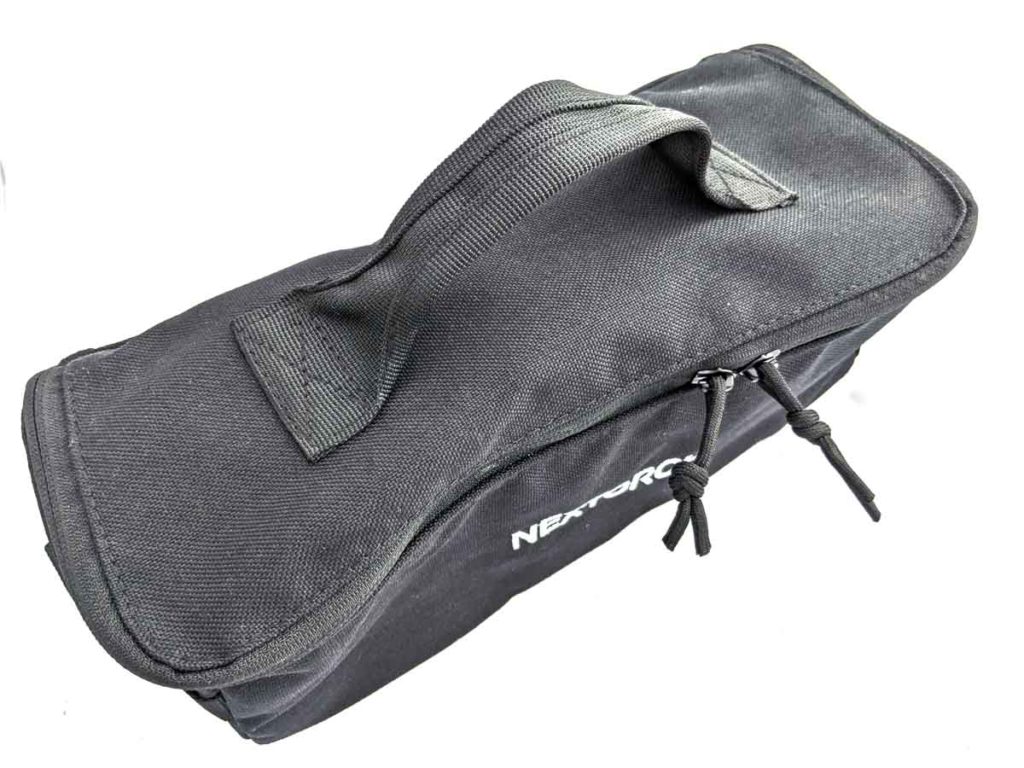
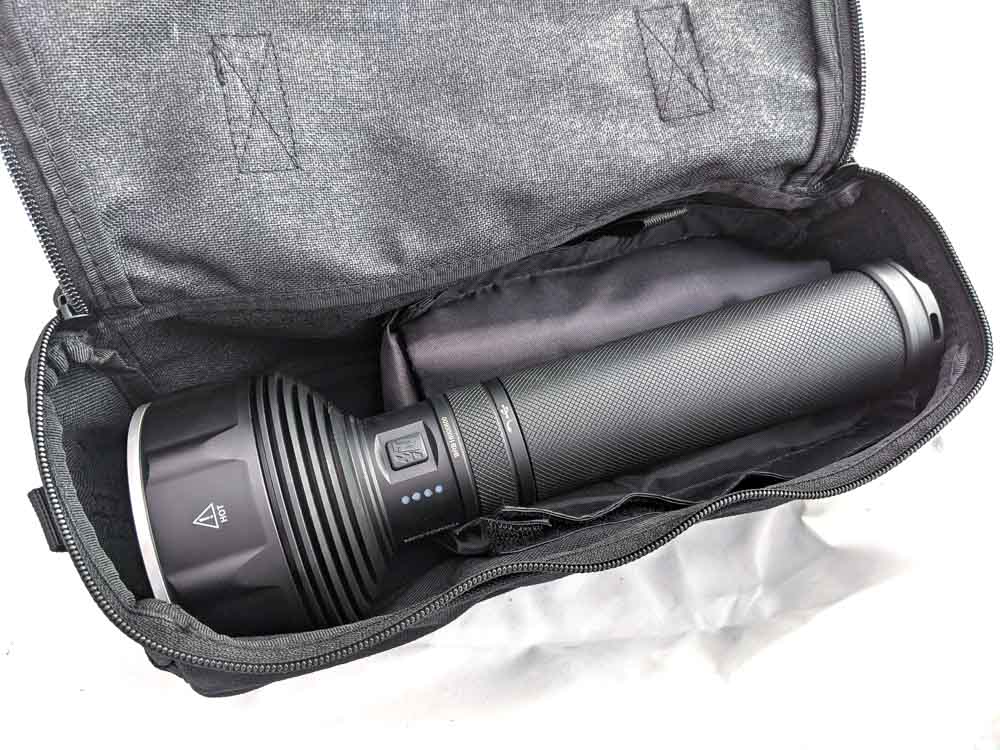
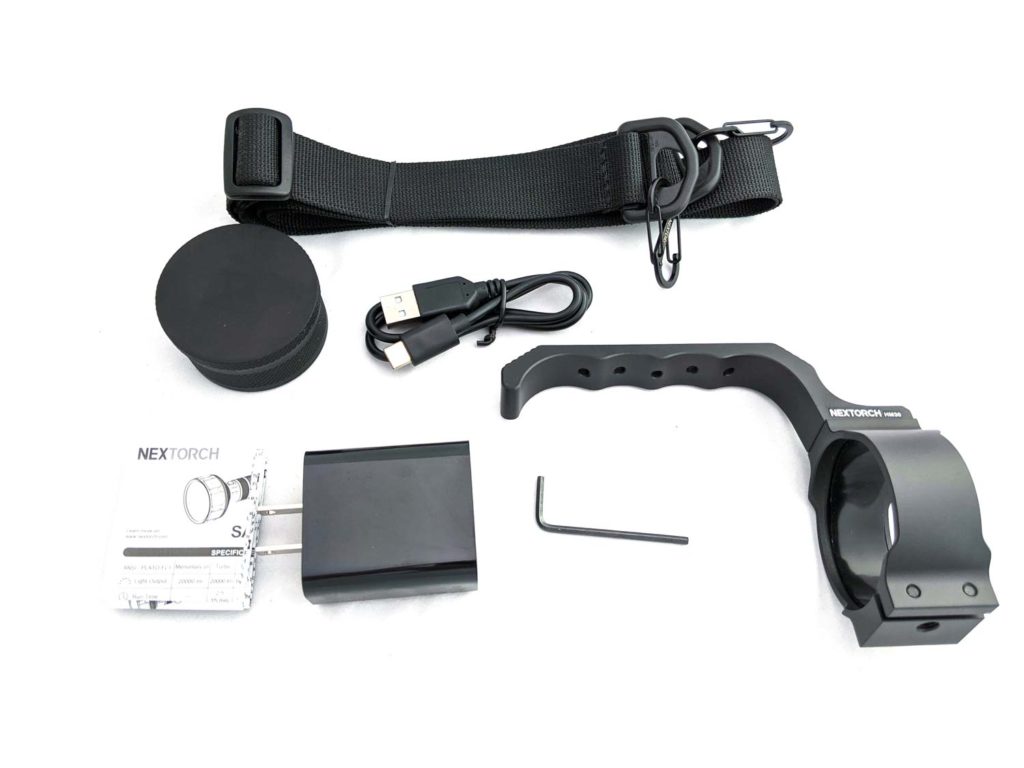
Flashlight in use
At 1.5kg (3lb 4oz), this is not an EDC light. In fact, it weighs the same as 12 Emisar D4V2s (one of my larger EDC lights) or the same as 3 Acebeam K30-GTs (the heaviest jacket pocket light that I’ll take on a long walk) or 70 Lumintop GT Nanos (because that’s important information you should know).
The NEXTORCH ST31 is a similar size and weight to the Acebeam X65 and X70. If you’re carrying the ST31 somewhere then it’s going to be obvious that you mean business.
I don’t have many massive lights but the ST31 is actually about the same weight as my Astrolux MF04. The MF04 is short but with a massive head, so doesn’t balance well. The ST31 on the other hand has a long body and a much smaller head. This makes it much easier to balance in 1 hand, with your thumb on the switch. The body is about as wide as 4*18650 cell flashlights, so easy enough to grip if you have medium to large hands but after a few minutes, you may want to use the shoulder strap. The light knurling all around the body tube helps with the grip too.
As it’s well balanced you can even hold it above your shoulder with your palm up. This means that the light rests on your palm and there’s no strain on your fingers. When holding like this you can easily reach the switch with a finger.
NEXTORCH provides a shoulder strap with the ST31. This is an inch wide and adjustable in length, with a small S-shaped carabiner at each end. One end attaches to the tail cap at one of 3 points. The carabiners seem to be a tight fit on the tail cap, so I’d recommend adding a split ring. The head end comes with a split ring already attached. There’s only 1 attachment point at the head, which is 90 degrees to the right of the switch – perfect for your thumb as long as you’re right handed like me.
Another carry option is the HM30 handle, which also works with the smaller NEXTORCH ST30. The handle has a rubber grip inside so it doesn’t scratch the flashlight and a 1/4″ tripod thread. It goes on backwards to what I was expecting. First, unscrew the head and body, then loosen the handle’s screws with the hex key. The handle goes on the body with the attached end towards the tail, then the body screws back into the head. You can then shuffle the handle as far forwards as you want for a good balance. I found having the handle inline with the switch worked best, so the switch can be activated whilst holding the handle. This works better than fixed handles on other lights, which are often too far from the switch to be usable. The handle also stops it rolling around on a table.
The side switch is nice and big with a rubber boot and seems like it won’t get activated accidentally. It’s a 2-stage switch, so you can activate it with a fairly light touch but a full click requires more force.
Pocket carry? Nope. This is the same weight as 70 GT Nanos, remember? Though if you did pocket carry it somehow, thanks to the Smart Output Adjustment feature your clothes should be safe from melting.
Tail stand? Yup, this works fine and is actually more stable than I expected. More wobbly than a soda can style light, so tail standing it on the ground outdoors may not be best.

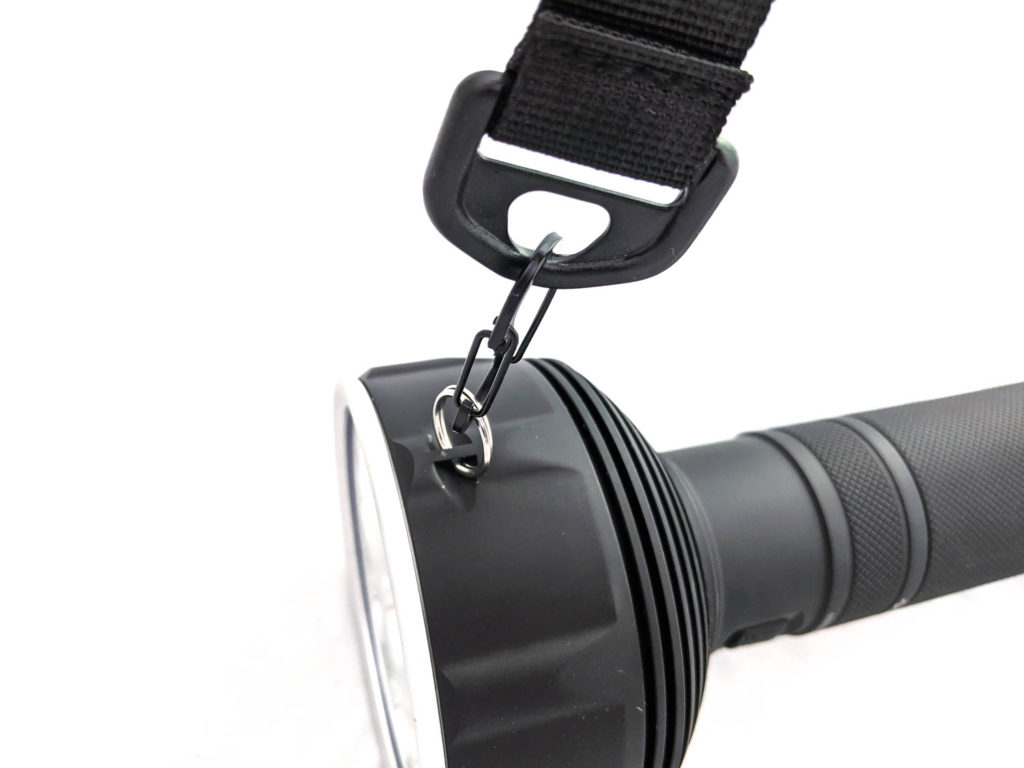
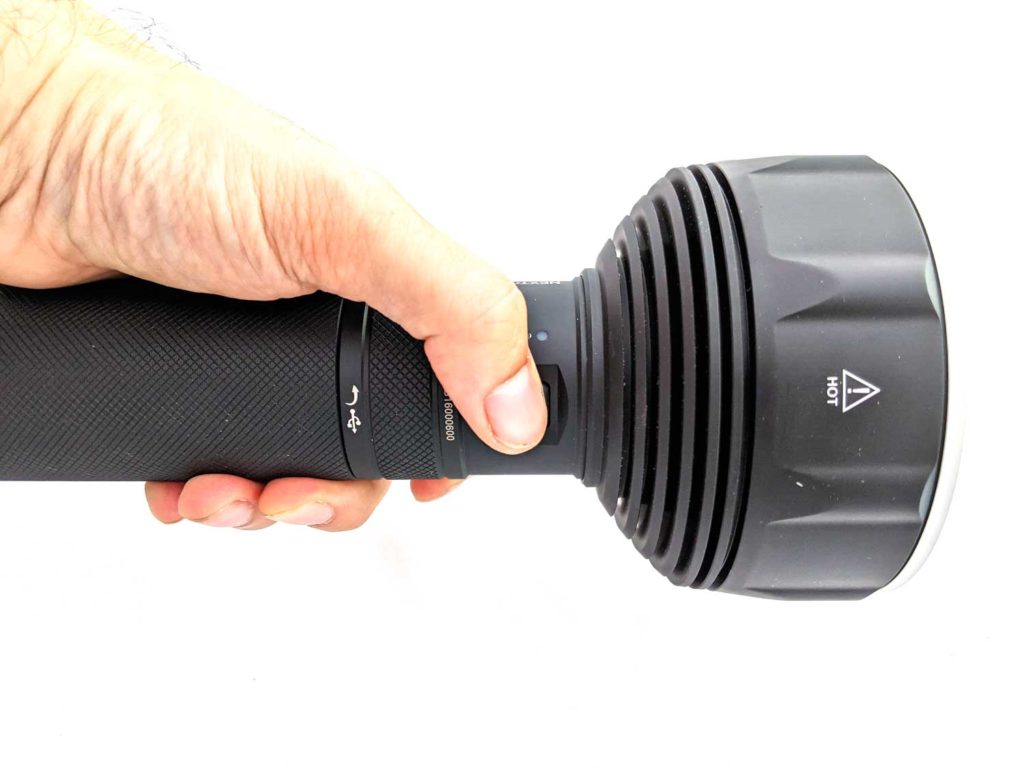
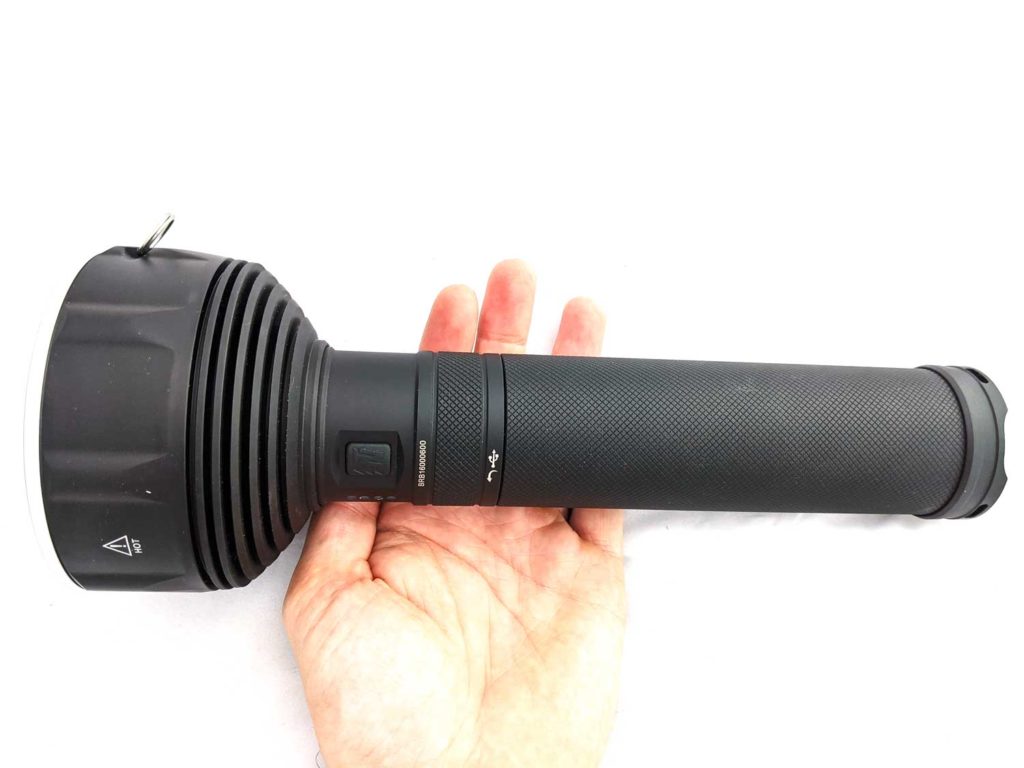
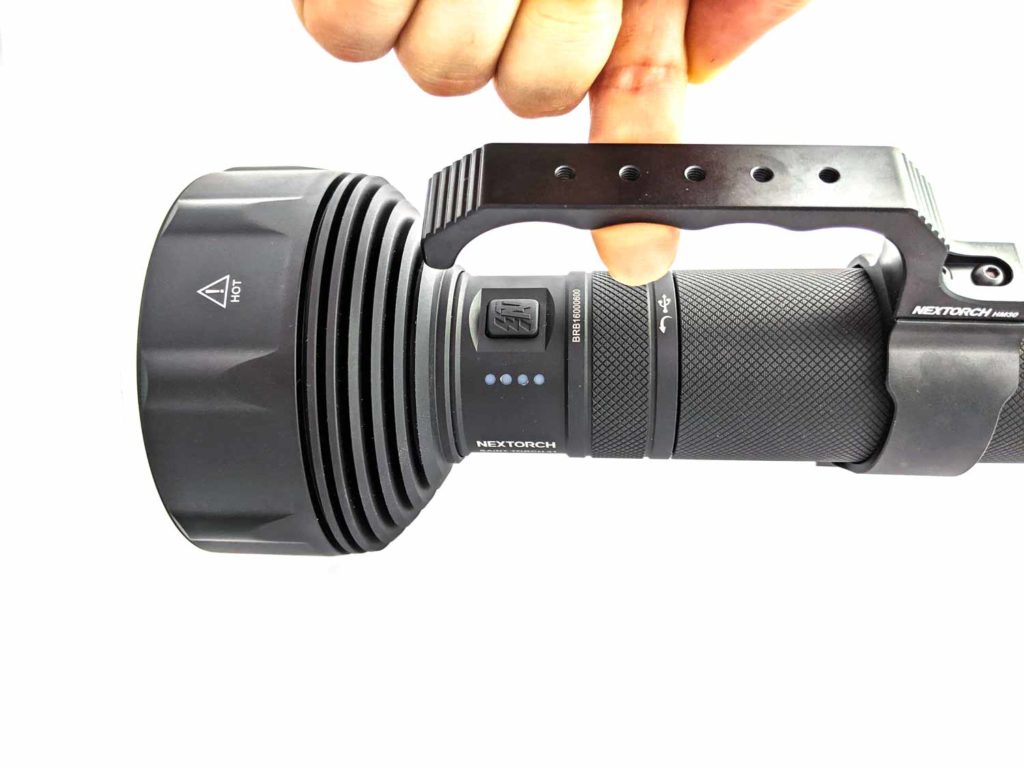
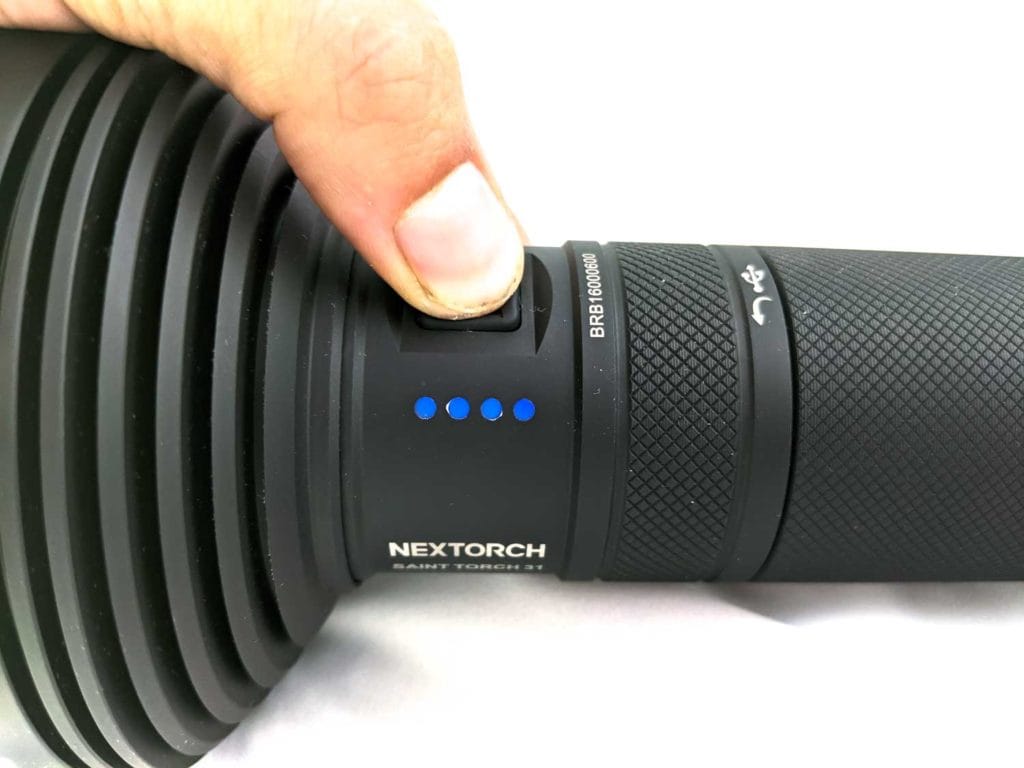
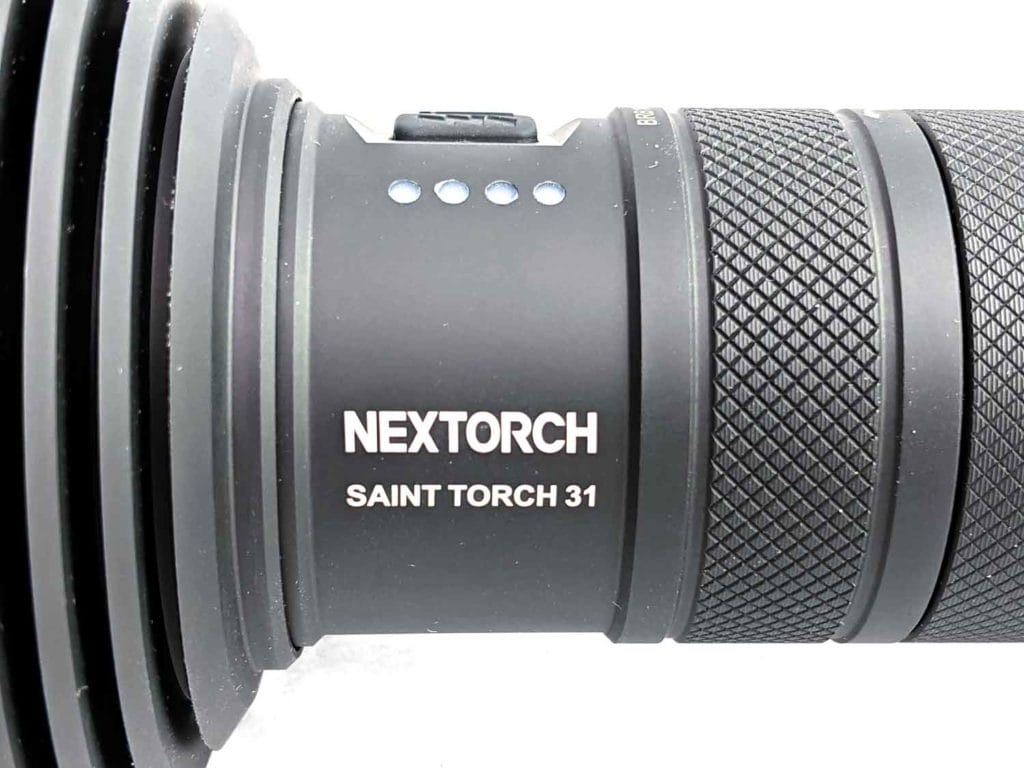
Build Quality, and Warranty
I have to admit, I thought NEXTORCH was a budget brand before I picked up the ST31. The build quality is far from budget though. In fact, with similar anodising and knurling you could fool someone into thinking the light was made by Acebeam.
The threads are square cut and fairly smooth – smooth enough but not the buttery smooth I’d like in a light of this calibre.
The aluminium has a slightly matte anodisation and results in a dark grey / light black color flashlight. Nice.
All the important edges are beveled or chamfered. The heat fins towards the body are a little sharp but this isn’t an issue unless you actively try to hurt yourself on them. The heat fins are deep and thick so should make a big difference with the heat.
Overall I’m very happy with the build quality of the ST31. All the accessories seem to be good quality too.
One thing to note is the use of a proprietary battery pack. This isn’t as easy to replace as individual cells but I can’t imagine discharging and charging it so much that the cells noticeably degrade.
Borrowing from Gabriel’s L10 Max review on the warranty: NEXTORCH has a 15 day replacement policy. There is a 5 year repair coverage. Accessories are not covered except for batteries which are covered for 1 year. In the event that an issue arises that is not covered under the warranty, NEXTORCH can arrange to have the product repaired for a reasonable fee.
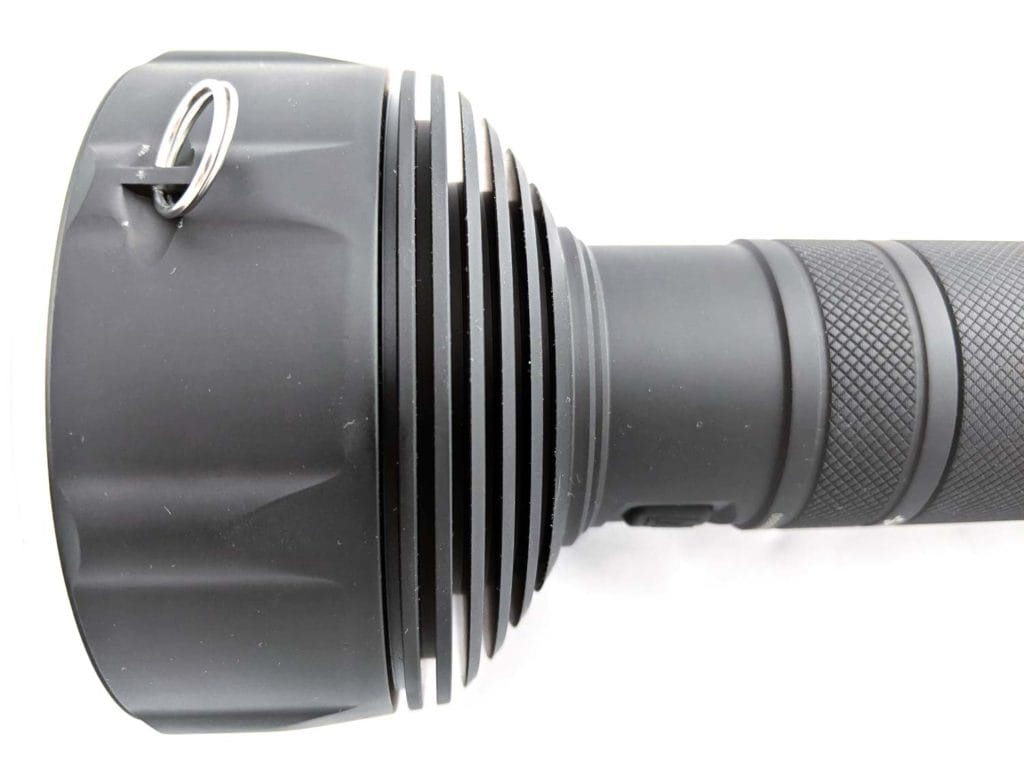
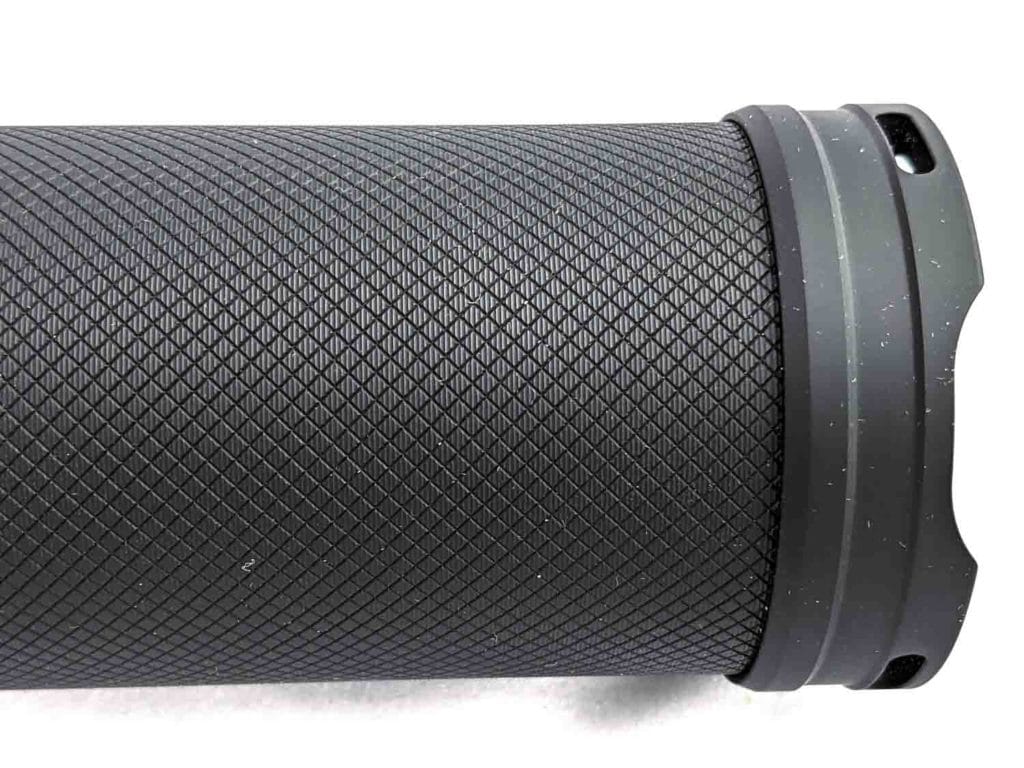
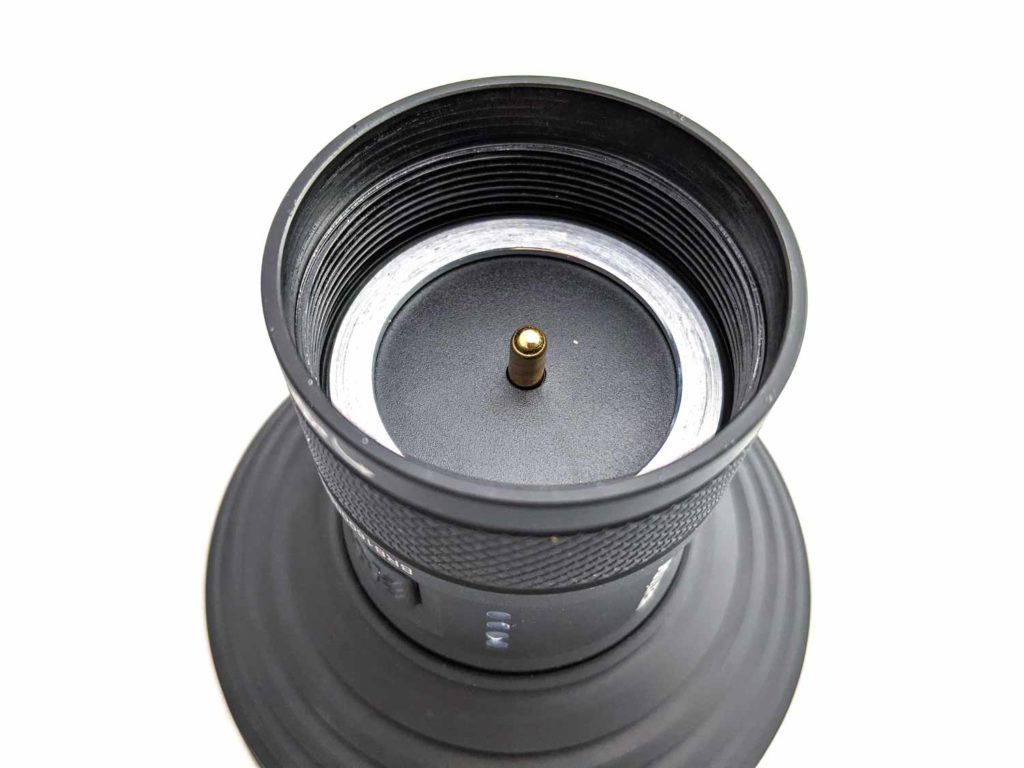
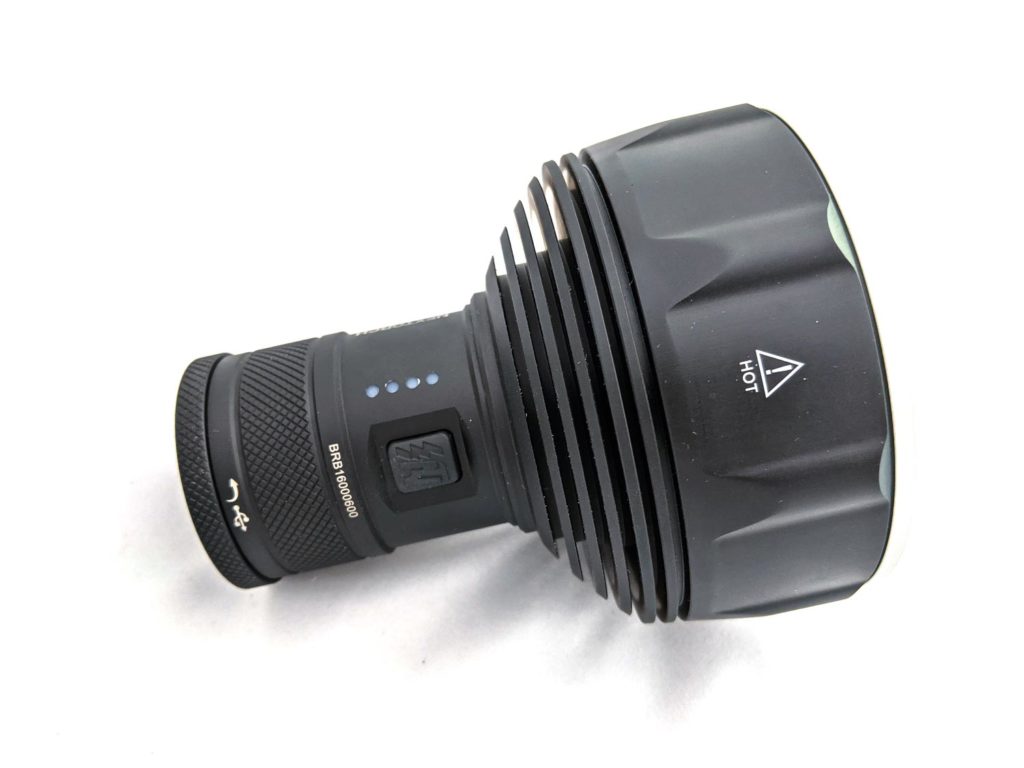
LED, Lens, Bezel, and Reflector
The box and manual says the ST31 has 8 lots of CREE XHP50 LEDs. I know for a fact that the flashlight comes with the second generation of the LED, the XHP50.2. Whilst XHP50 LEDs are made up of 4 XP-G2 LEDs with a gap in the phosphor between them, the XHP50.2 uses 4 XP-G3 LEDs without a gap. This gives more output but the second generation are known for having worse tint shift, AKA the infamous “CREE rainbow”.
NEXTORCH has combated the CREE rainbow to an extent by using a light orange peel reflector. Whilst the tint isn’t even from the hotspot to the spill, it’s not nearly as bad as some other lights I have. There’s a slight shift to green outside the hotspot and an even cooler blue/white at the edge of the spill.
These LEDs are cool white, most likely 6500K, and still have their dome.
The highest bin XHP50.2 LEDs can just handle 5000 lumens at their maximum, though most flashlights with XHP50.2 LEDs get 3500 lumens out the front at most from each one. At 20,000 lumens between 8 LEDs, NEXTORCH is getting a more conservative 2500 lumens from each.
The XHP50.2 are 5050 sized LEDs and came in 3V, 6V and 12V, depending on whether they’re wired in parallel or serial. I can’t tell what voltage the ST31 is using.
Above the reflector is an o-ring, followed by a glass lens with an anti-reflective coating. This coating makes the edges of the reflectors look purple when the light is on. A bit weird but not a problem. The silver-coloured bezel sticks out about 3mm.
The XHP50.2 LEDs combined with reflectors that are each around 25mm wide results in a slightly throwy beam and a throwyness of 6.8 cd/lm. That’s a bit throwier than the Sofirn SP36 or the Acebeam X45 but not as throwy as the Fenix LR50R, LR80R or Acebeam X65.
This section of the review took a while to write, as I shined the 20,000 lumens in my eyes from a short distance about 3 times and had to keep stopping to get my vision back. NEXTORCH warns “Do not look into the beam of light!“ and “This flashlight is not suitable for children under 16 years!” I’m well over 16 but perhaps I shouldn’t be allowed dangerous tools like this…
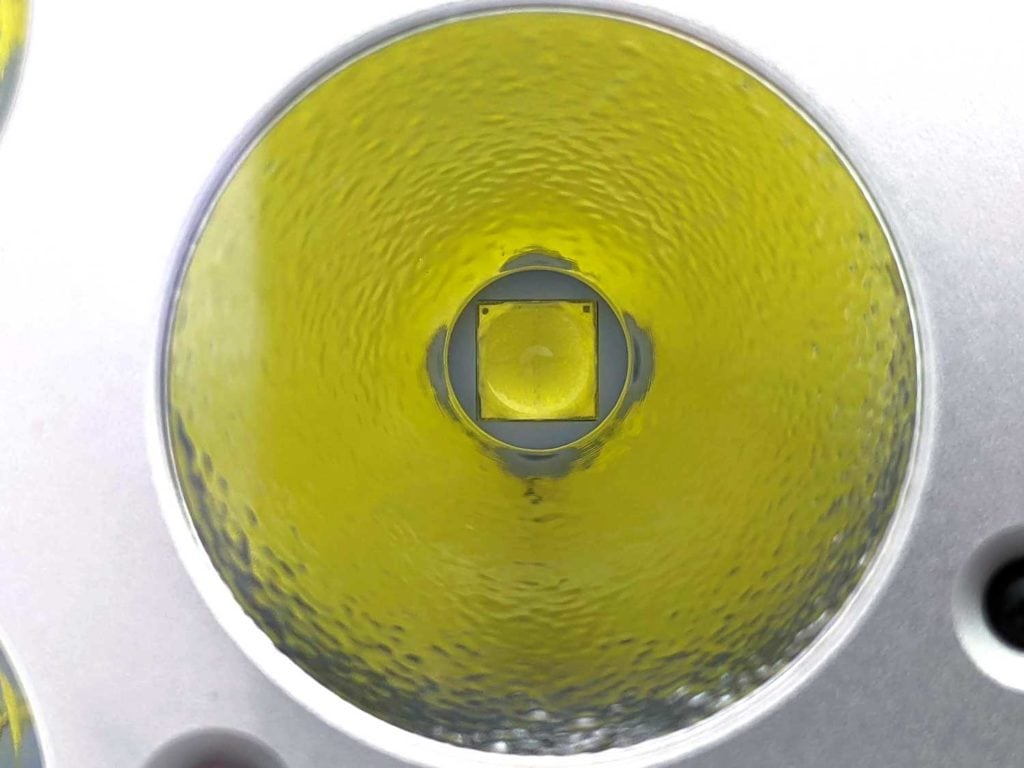
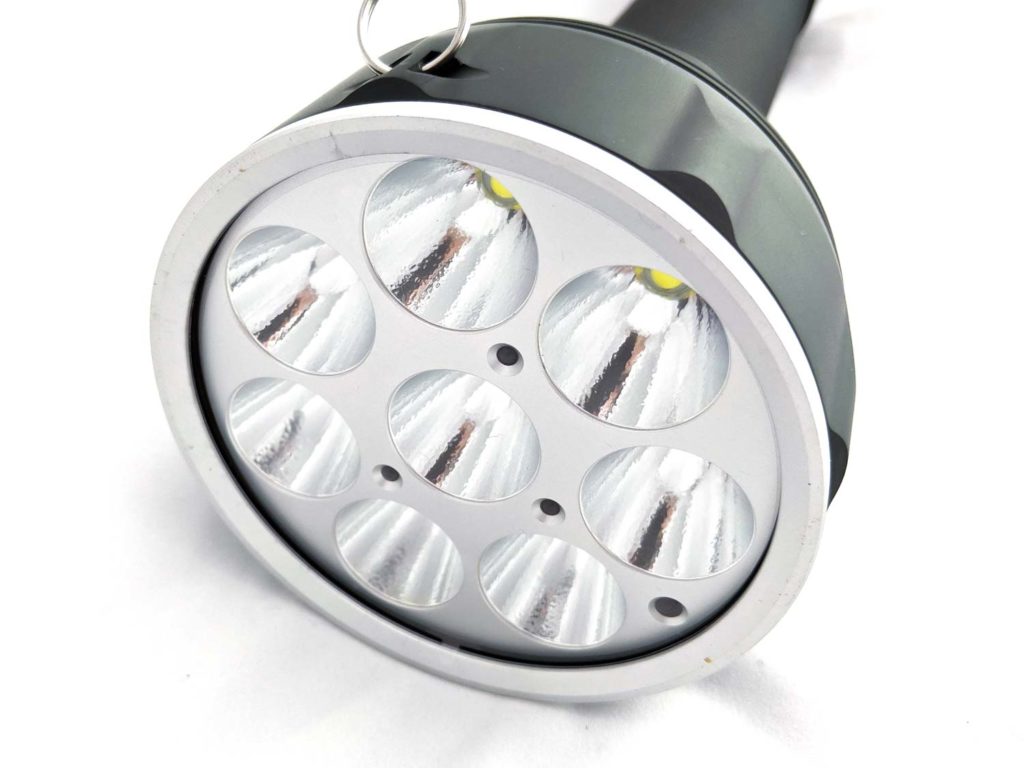
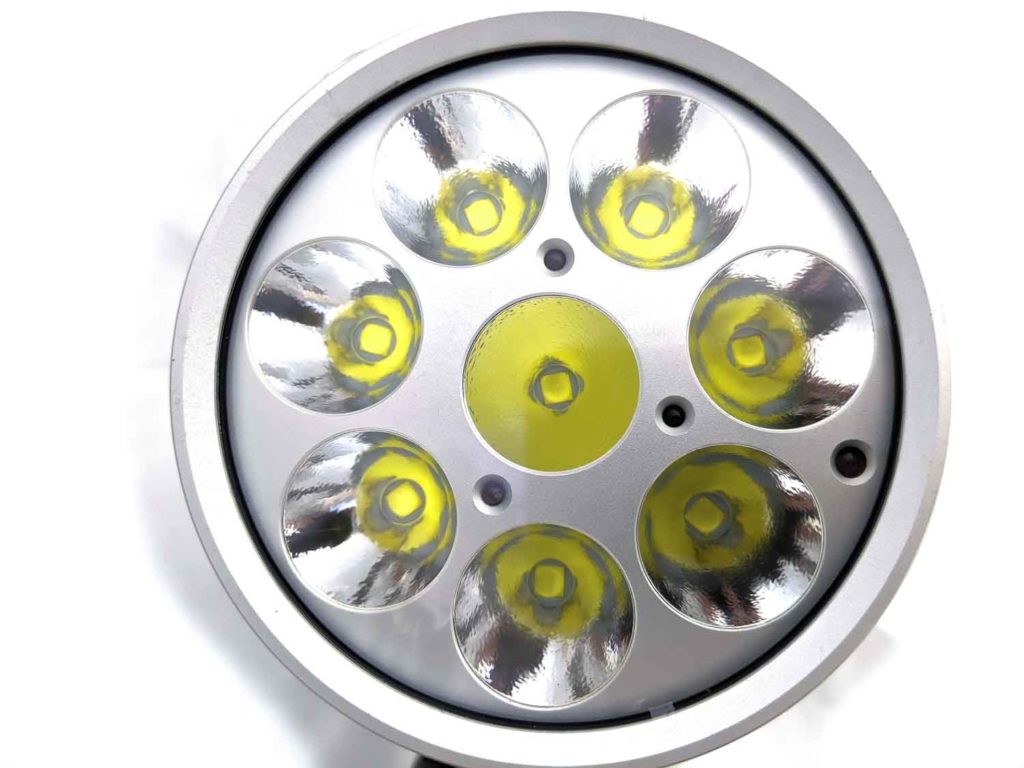
Dimensions and size comparison
- Length: 28.5 cm / 11.2 in
- Head diameter: 10.66 cm / 4.19 in
- Body diameter: 4.99 cm / 1.96 in
Weight:
- With battery pack: 1543g / 3 lb 6.4 oz
- Just the head (and cap): 933g / 2 lb 0.9 oz
- Just the battery pack (and cap): 660g / 1 lb 7.3 oz
Flashlight comparison
I clearly need more big lights to compare to. The MF04 is the only other “massive” light that I have, though it is a pure thrower, unlike the ST31. The ST31 is a much more normal size and although it’s longer, doesn’t feel as big or awkward to hold.
The Imalent R60C is the closest thing I have to the ST31 in terms of output, with the R60C throwing a little further but not as many lumens. The Imalent is tiny in comparison to the NEXTORCH and doesn’t have as much mass to absorb the heat.
I included the Wurkkos DL40 and Sofirn SF47T as they both have cells in series, like the NEXTORCH . They’re not as nearly bright but my DL40 has the same host as the 13,000 lumen DL70 that Nick reviewed recently.
From left to right:
- Astrolux MF04 (4*18650)
- NEXTORCH Saint Torch 31 (6*21700)
- Imalent R60C (3*27100)
- Wurkkos DL70 (2*26650)
- Sofirn SF47T (2*21700)
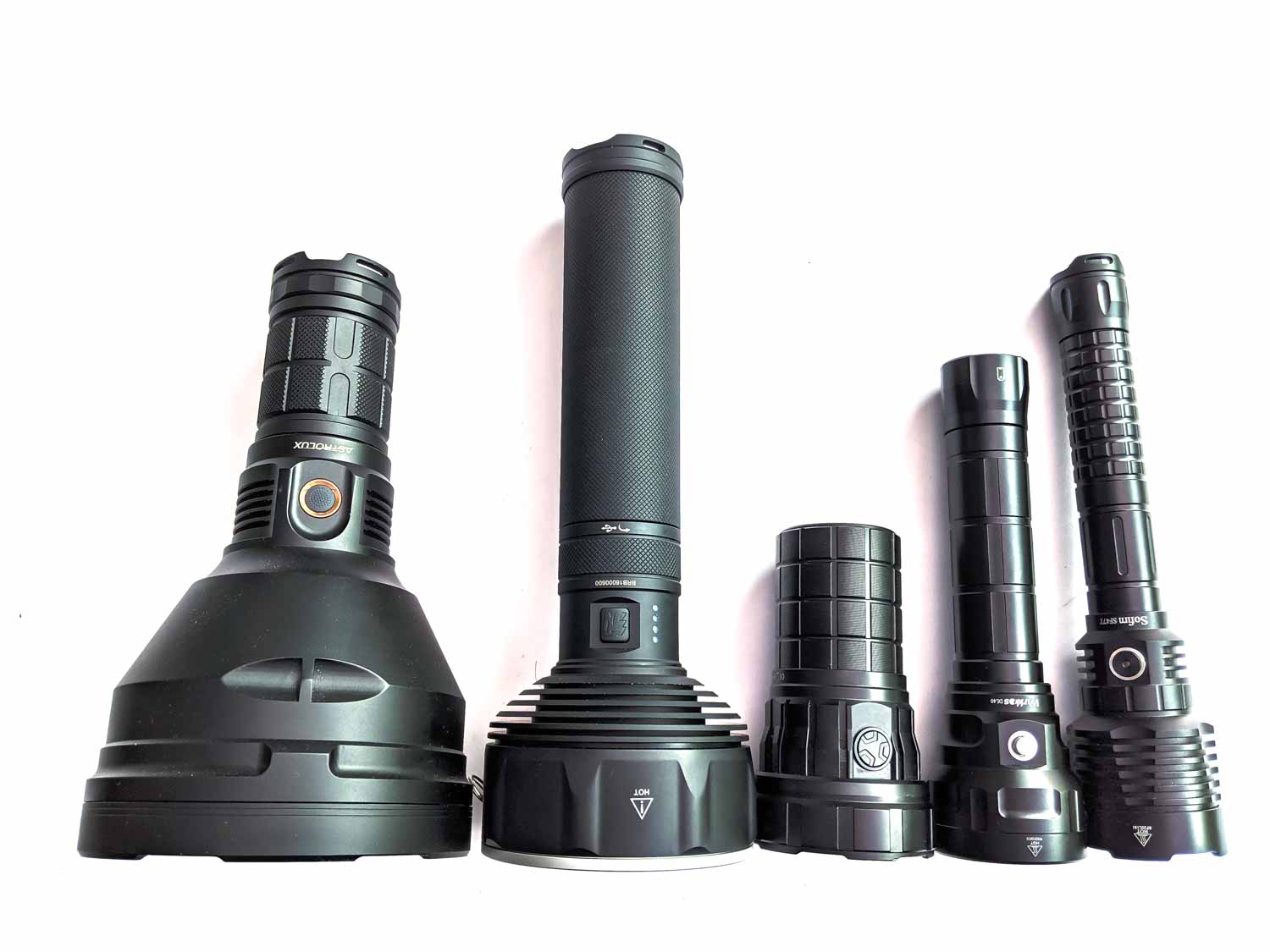
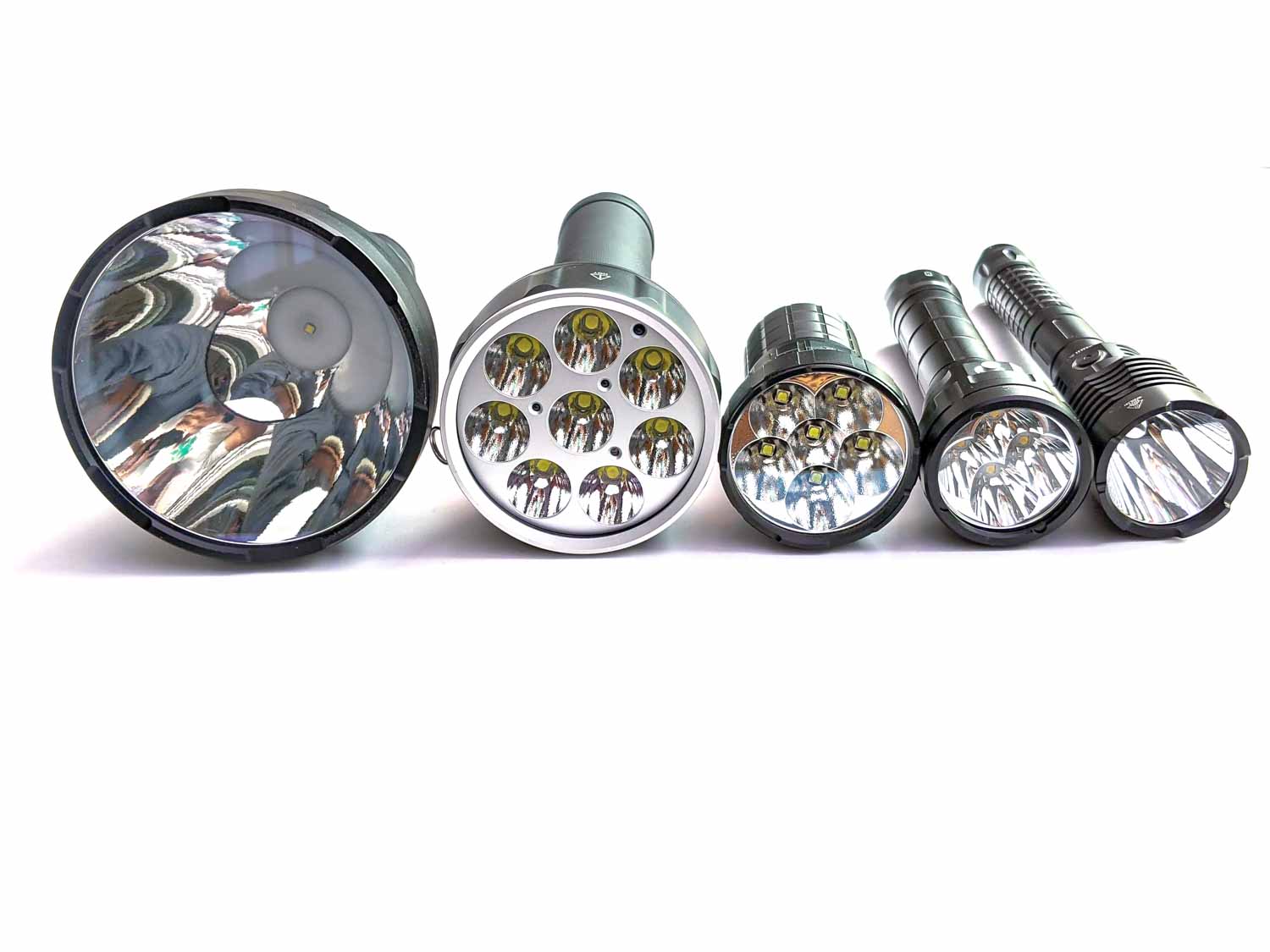
Driver & User Interface:
The NEXTORCH ST31 has what I guess is technically a forward-clicky mechanical + e-switch. You can half-press it for a momentary action or fully press for it to click on.
The ST31 always starts in turbo. That would be terrible for an EDC light that’s used around the house but for a big search and rescue light, it’s not so bad. I’d still prefer starting from low as the turbo mode is going to destroy everyone’s night vision. If you’re taking this on something like a camping trip then you’ll definitely want another light that can be turned on in a lower mode.
Strobe is in the main mode group but is easily avoided by turning off after you get to the low mode. Strobe seems to be at turbo level. SOS is hidden away under a 3-second hold from any other mode and is the same brightness as medium.
Available modes: Turbo, High, Medium, Low, Strobe, SOS
From OFF:
- Half press and hold: Momentary turbo
- Full click: On (turbo)
From ON:
- Half press: change modes (high, medium, low, strobe, then back to turbo)
- Full click: Off
- Hold for 3 seconds: SOS
Mode memory:
- No. Always starts on turbo.
Low voltage warning:
- Yes, the light shuts off with low voltage. The battery pack measures 0V when it cuts out, until it’s given a little charge to reset it and it’s 18.55V, which is about 3.09V per cell
Strobe/blinkies
- Strobe (in the main mode group) is at turbo level and about 5Hz
- SOS (press and hold for 3 seconds) is at medium level
Lock-out mode:
- No lockout mode but you can quarter turn the body and head to disconnect it. If the switch is on then reconnecting the body and head will put the light back on turbo.
PWM
- I couldn’t detect PWM in any mode
Smart Output Adjustment
Turbo makes use of something NEXTORCH calls Smart Output Adjustment. This is a safety feature that drops down from turbo’s 20,000 lumens to medium’s 1700 lumens when it detects something close by reflecting the light. I’m pretty sure this uses IR LEDs. This works well and detects most objects around 35cm within milliseconds, then jumps back to turbo as soon as they’re moved away. High and other modes aren’t affected by the output adjustment.
This output adjustment is triggered by my integrating sphere. I thought this would mean no run time for turbo but NEXTORCH has a special “test mode” that disables the output adjustment. Test mode is activated by half pressing and holding for 10 seconds whilst on low (going past strobe) and stays disabled until the light is turned off and on again. With the output adjustment disabled, the ST31 will heat things up (like skin) quickly, so be careful!
Batteries & Charging
The ST31 comes with a proprietary battery pack. Inside there are 6*21700 cells, though I can’t open it to confirm. NEXTORCH lists this as 6* 4800mAh and 21.6V, which means the 6 cells are in series.
The light also includes a charge indicator on the head, next to the switch. This uses 4 blue LEDs to indicate how much capacity is left. The power indicator lights up for 3 seconds when the light is first turned on.
As you unscrew the body you can see 2 USB ports within the threads: 1 USB-A and 1 USB-C. Keep unscrewing and you’re presented with the power information and a small switch. The switch lets you pick between LED, off and USB. Off will disconnect the cells, eliminating any parasitic drain. This is useful for storage or transporting but probably won’t make much difference in normal usage. LED is the default and lets the battery pack power the flashlight.
NEXTORCH provides a 2 part seal cover that screws on to the head and the body tube. The 2 part cover also screws together to provide a waterproof tin, about 2cm deep, handy for pills or keeping tinder dry. The caps are handy to protect the head and body tube when they’re apart. You can rest the cap on the body tube when a cable is plugged in but unfortunately the ports aren’t accessible when the cap is partially screwed on.
Another thing that’s a bit of an annoyance is that the charge indicator is on the head, so you have to disconnect the USB cable and screw in the head to see what % charged it is.
Power bank
Switch the battery pack’s little switch to USB and you now have a 103.68Wh power bank, equivalent to 28,800mAh in a normal power bank. This is quite substantial, with most power banks being around 10,000mAh. You should be able to charge most phones fully 6 to 10 times with this. This mode is indicatored by a small blue LED near the switch.
My USB tester says the USB-A port on the battery pack supports Type-C PD, as well as QC2.0 at 5V/9V/12V and Samsung and Huawei’s proprietary charging. This is a good range of outputs, though I’d have liked to see a 20V output and support for QC3.0 to be able to power laptops. From my experimentation, the USB-C port can only be used for charging the battery pack, not for charging other devices.
I managed to get the full 5V/3A and 12V/1.5A out from the power bank.
Charging
The battery pack also charges via USB. This took just under 9 hours with the provided USB-A QC AC adapter, which charges at up to 12V/1.5A (18W). My USB meter showed 117Wh going into the cells, which is fairly standard efficiency. Charging worked with a C-to-C cable too, which was good to see. When plugged into my 65W Baseus power bank via USB-C, neither one knew which device should be charging the other, so they both sat there patiently. Charing from A-to-C worked fine either way round.
You can charge with the little switch in any mode: off, LED or USB. There’s a small green indicator light by the USB-C port to show it’s connected. Annoyingly the indicator light doesn’t turn off, so although charging stops at a sensible 25.2V, you can’t tell whether it’s still going or not.

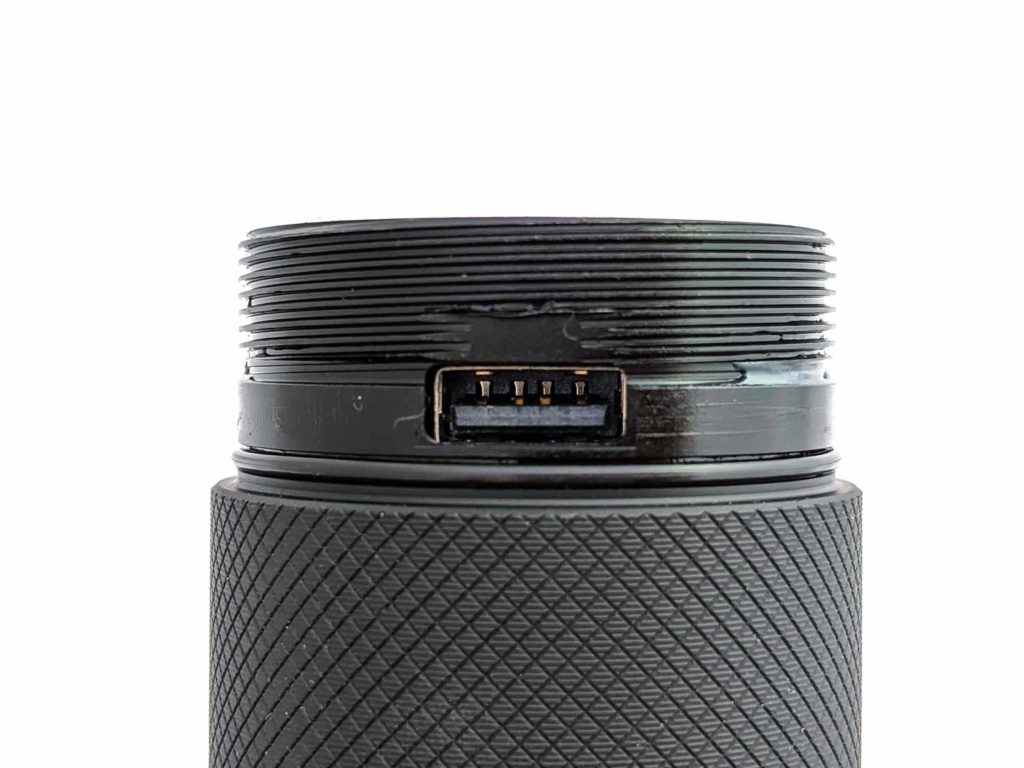
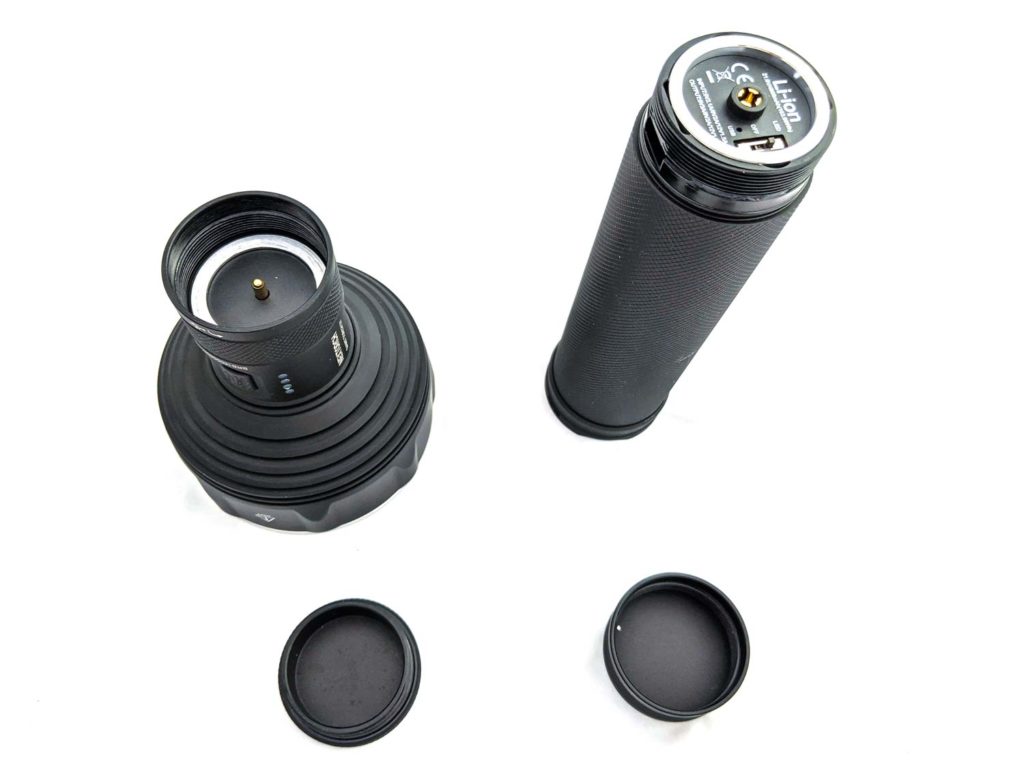
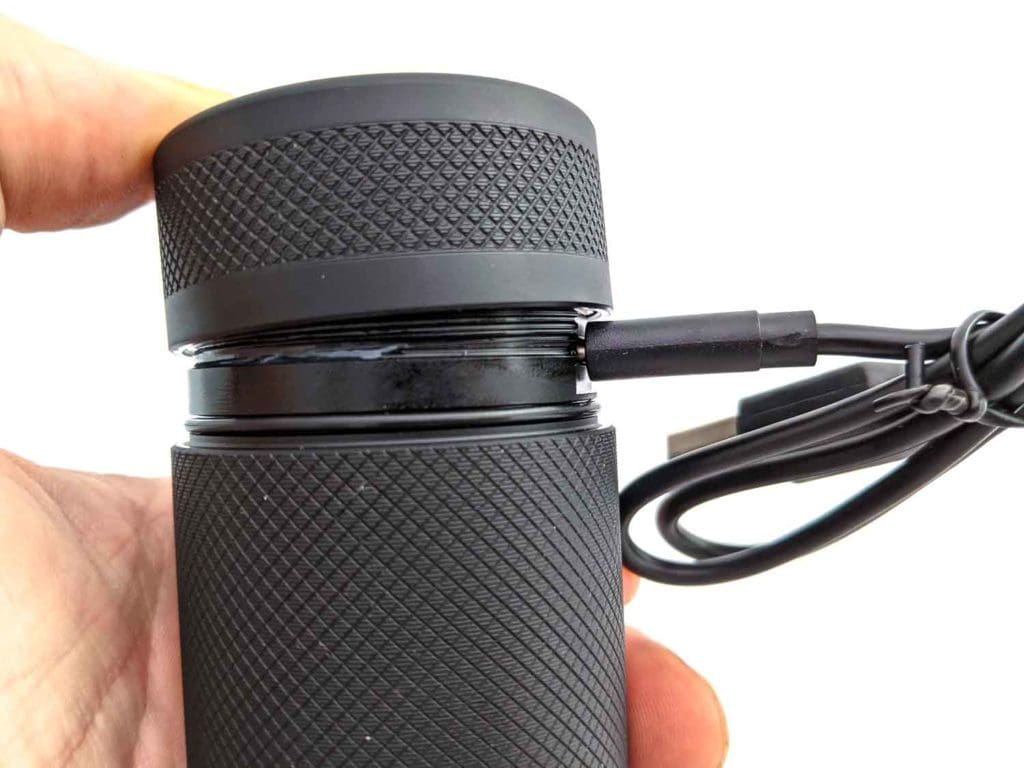
Performance
Lumen measurements (for each mode)
The NEXTORCH ST31 was a bit big for my normal integrating sphere, so I built a temporary integrating box that could accommodate the 11cm head. This was calibrated with a few other lights and seemed to give reproducible results. Normally I’d expect my lumen measurements to be within 10% but these may be a bit further out.
Measurements are done with a UNI-T UT383S lux meter and Adafruit TSL2591 connected to a Raspberry Pi (using RuTiTe by bmengineer).
Unfortunately I couldn’t get current measurements due to the structure of the light.
| Mode | Specs | 10min | 30 sec | start |
| Low | 90 | – | 117 | 117 |
| Med | 1700 | 1512 | 1531 | 1634 |
| High | 6000 | 2080 | 5610 | 5625 |
| Turbo | 20000 | 4774 | 20,374 lm | 21,997 lm |
Runtime graph
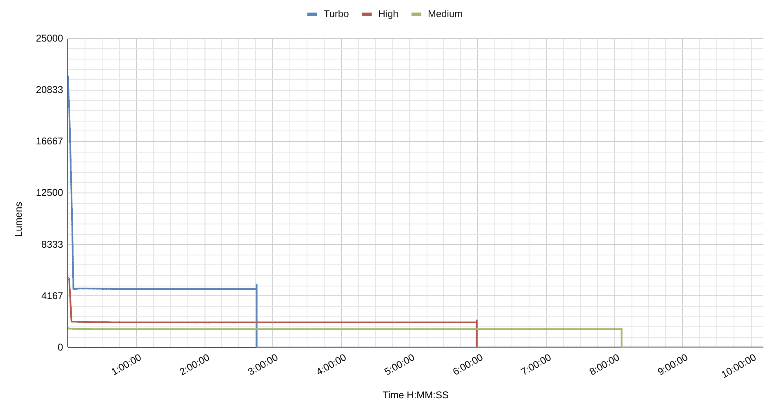
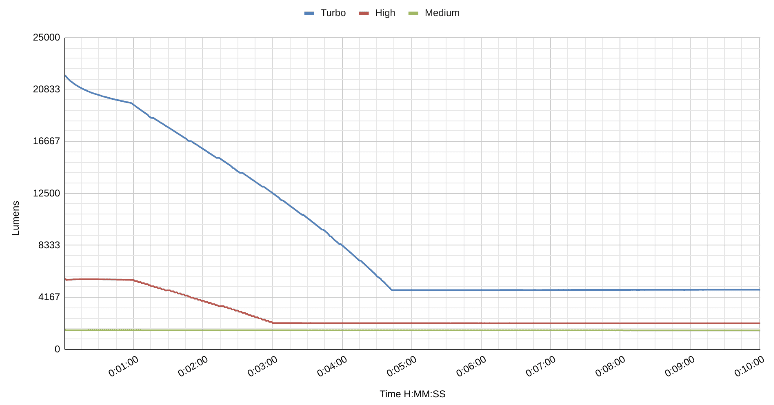
On turbo, the Saint Torch 31 hit close to 22,000 lumens when turned on. It starts falling immediately and I measured just above the specification’s 30 second ANSI rating of 20,000 lumens. No exaggerated numbers here. Output falls gradually: hitting 19k, 16k, 13k, 8k and 5k after each of the first 5 minutes. After the first 5 minutes, the ST31 holds steady at a hair under 5000 lumens for 2 hours 45.
The head gets hot during this process, with the head getting up to 60℃. Due to the size, the tail end of the flashlight stayed below 40℃. Using the handle is a good idea but it shouldn’t be dangerous to use the light without it. NEXTORCH may have been able to get away with a slower step down on turbo, as long as they made the heat warnings clear.
For comparison, the similar size Acebeam X65 sustains around the same output after it steps down and the X70 manages to sustain around 7000 lumens but for a shorter time.
High is rated at 6000 lumens but I measured 5625 at turn on, which it holds without faltering for a minute. Between the 1st and 3rd minute the light drops down to 2000 lumens. It maintains 2000 lumens for a massive 6 hours. That’s the equivalent to 2000 lumens for 1 hour from a single 21700 cell, which is only achieved by a few very efficient flashlights.
I was hoping high wouldn’t drop down as far here, as the light can clearly handle upwards of 4000 lumens without a sweat. After 3 minutes there’s not much difference between high and medium.
Medium was close to the 1700 lumen spec and stayed above 1500 lumens for 8 hours. I didn’t do a run time for low but NEXTORCH claims 81 hours (over 3 days), which I’m confident it can manage based on the efficiency of the higher modes.
Throw numbers:
Throw was measured indoors at 10m with a UNI-T UT383S lux meter at 30s. I measured the throw a little higher than NEXTORCH specs.
| Mode | Specs | Candela measured | Meters | Yards |
| Low | – | 849 | 58 | 64 |
| Medium | – | 15,423 | 248 | 272 |
| High | – | 54,882 | 469 | 512 |
| Turbo | 136,900 cd 740 m | 166,179 cd | 792 m | 866 |
Beamshots
The distance to the building is 170m. Photos were taken with a Pixel 3a, set to 1/3s shutter speed and ISO 400, F1.8.
- NEXTORCH Saint Torch 31 (8* XHP50.2)
- Imalent R60C (6* SST70)
- Imalent RT90 (SBT90.2)
- Acebeam K30-GT (SBT90.2)
- Astrolux FT02S (4* SST40)
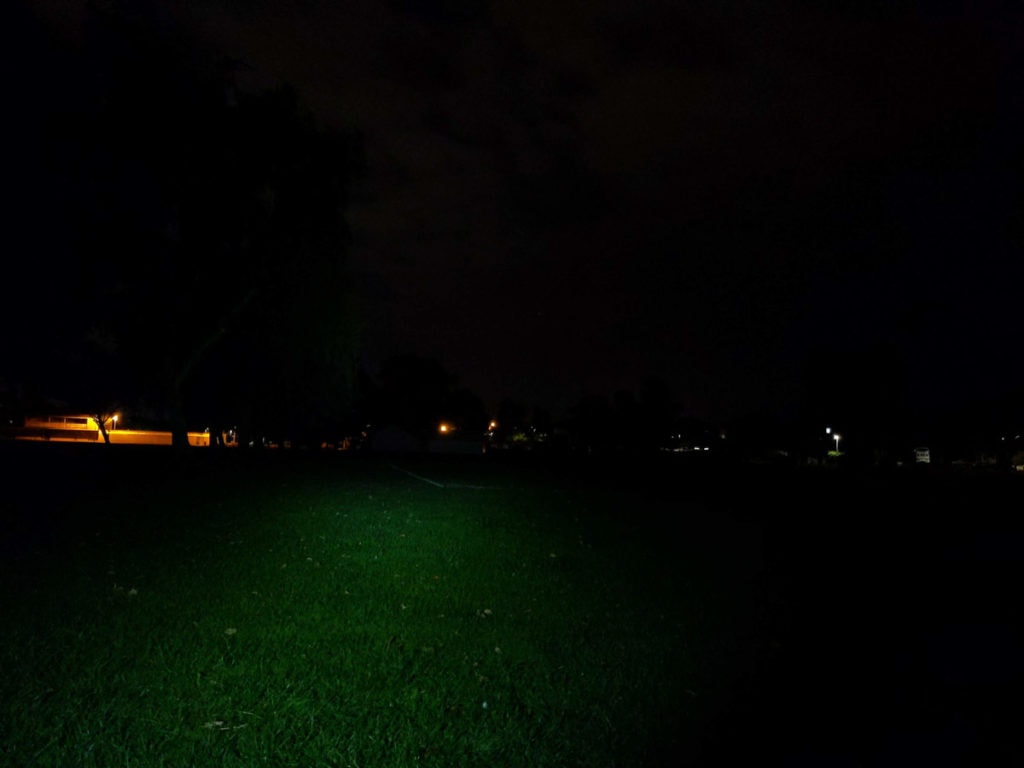
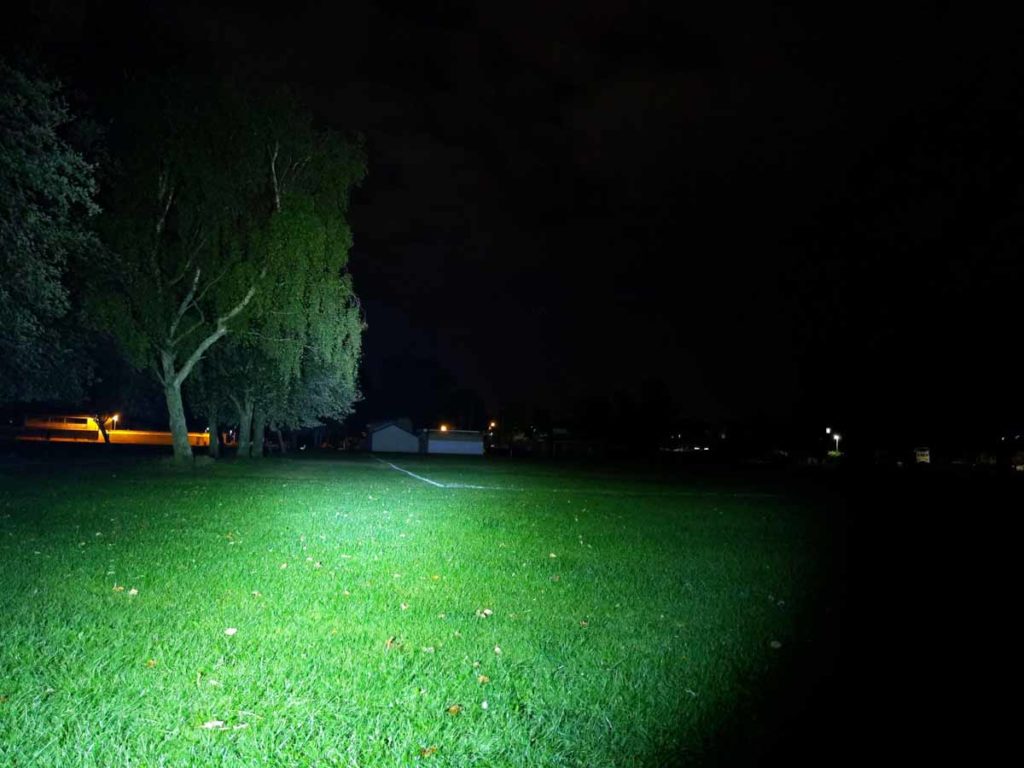
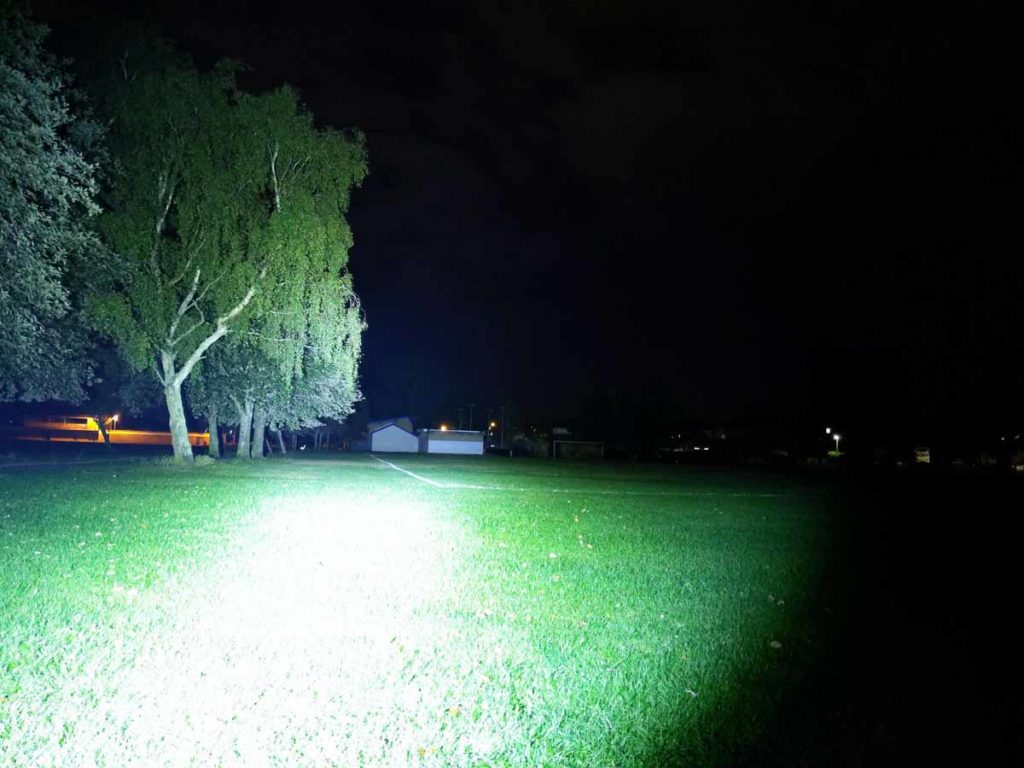
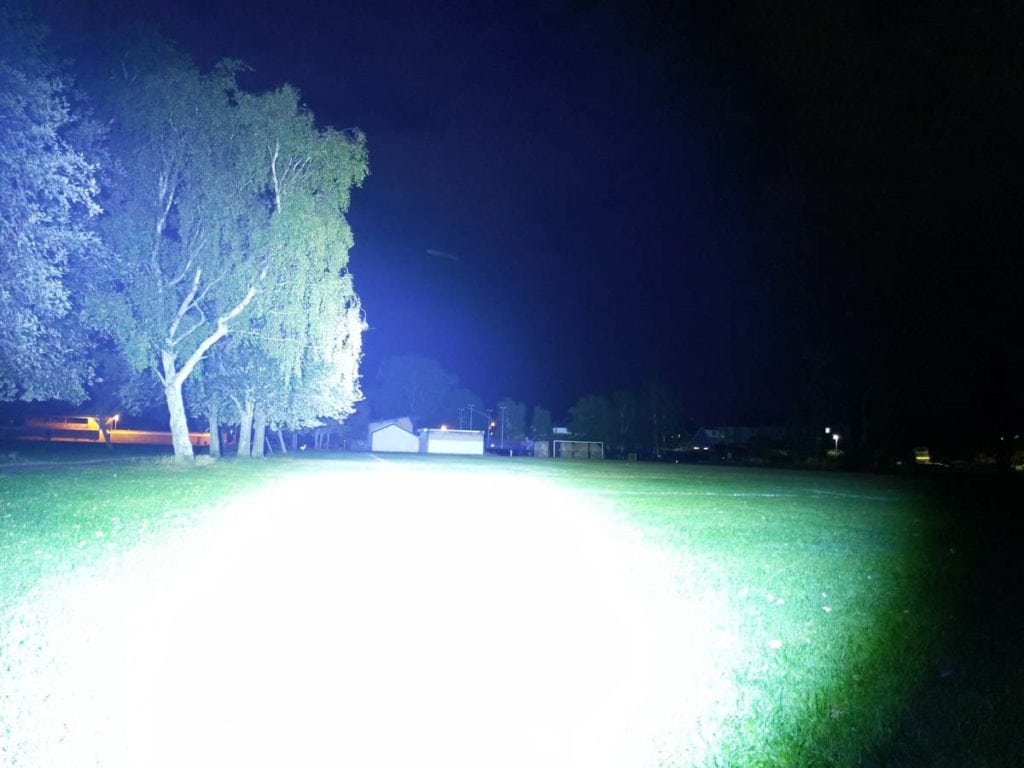
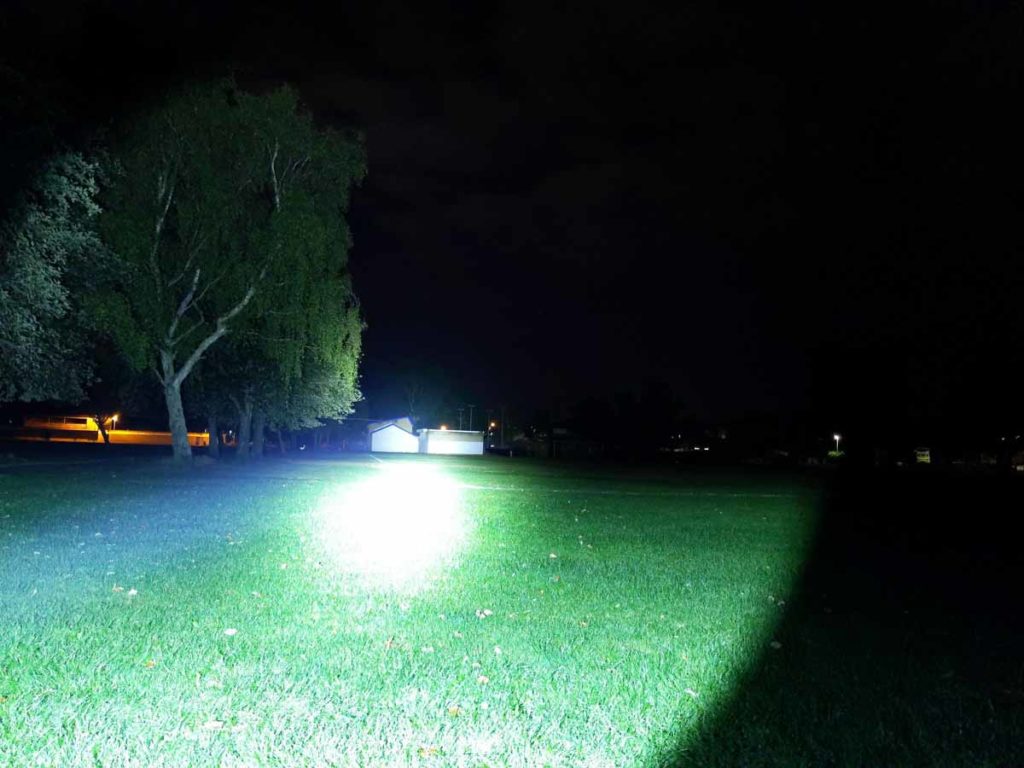
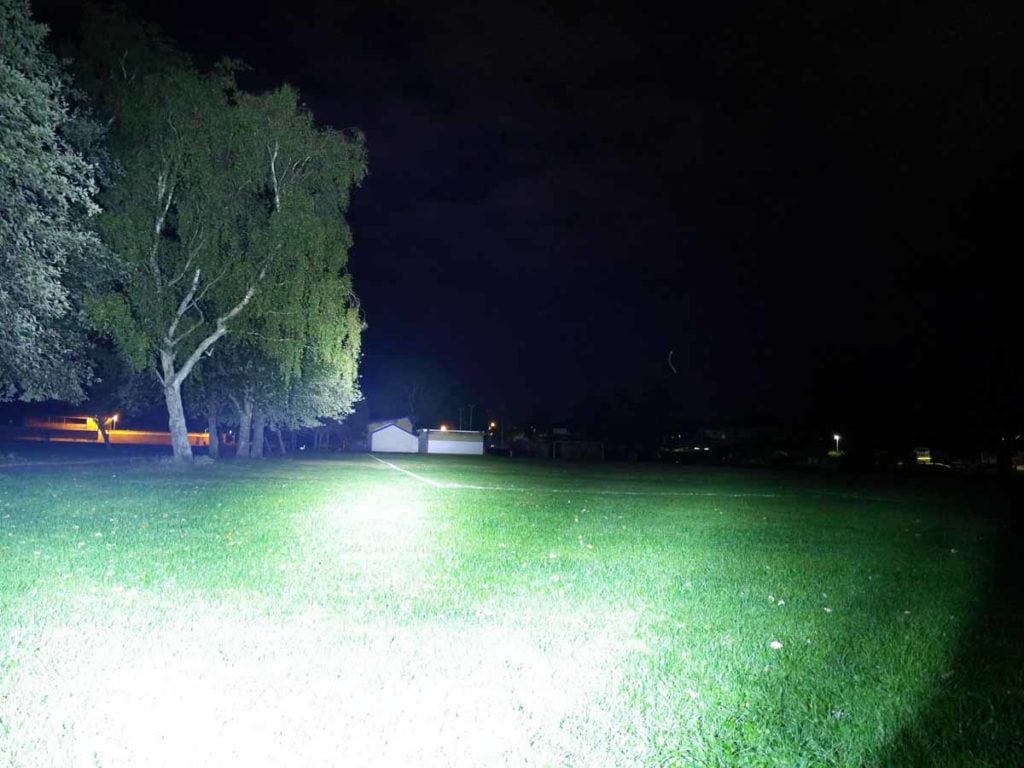
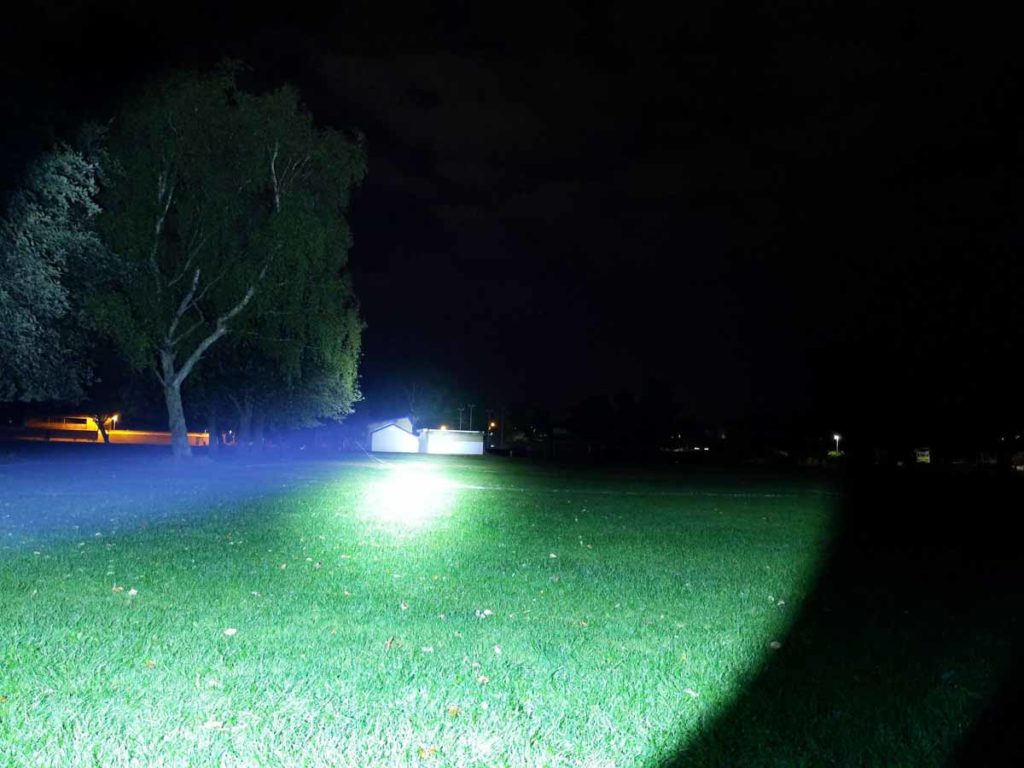
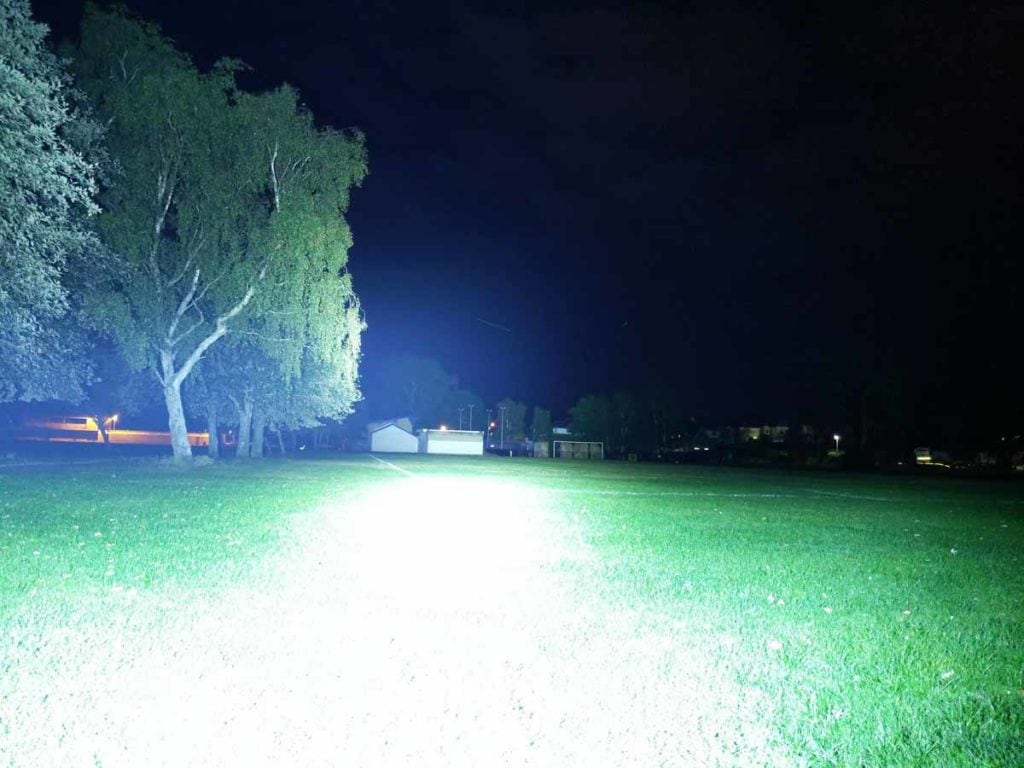
Disclaimer: This flashlight was sent to me for review at no cost by NEXTORCH . I have not been paid to review, nor have I been holding back on problems or defects.
Final Verdict
Pros
- 20,000 lumens!
- Built in fast charging
- High capacity power bank with USB-C PD and QC
- Comes with handle, shoulder strap and bag
Cons
- Always starts on turbo
- Charging indicator doesn’t turn off
- Expensive
Explanation on star ratings:
1: Avoid: my phone flashlight would be a better choice – 2: Poor: significant defect or issues, much better options available at the same price – 3: Average: some defects or issues – 4: Good: recommended (minor issues) – 5: Great: highly recommended

5 stars: ★★★★★
10 years ago we thought no one would ever need more than 1000 lumens. Now I’ve seen 20,000 and I want more!
The Saint Torch 31 may not reach as high on turbo as some of the biggest lights from Acebeam and Imalent but NEXTORCH are nipping at their heels, especially when it comes to sustained output and runtime. Not only is it bright, it also sustains 5000 lumens for almost 3 hours.
I normally have trouble with power banks, rarely managing to find the right combination of cables and chargers that can manage over 10W. I’m pleased to say that the ST31 has broken my streak of bad luck: the quick charging and power bank feature worked perfectly. The only annoyance here is that there’s no charge or capacity indicator unless you unplug it and screw the head in.
I would definitely change the UI if I could. If this were an EDC light then it’d lose a star for always starting on turbo. Whilst not ideal, it’s much less of an issue if you’re carrying the ST31, as chances are you’re the kind of person that also has a flashlight in your pocket too.
So… should you buy it? I can’t really say no, as the ST31 is an excellent flashlight. But it’s expensive. It comes in a fair bit cheaper than the Acebeam X70 or Imalent MS18 but it’s still serious money. If you’re going to spend multiple $100s on the brightest light possible then a couple of hundred $ more could get you something over twice as bright – at least for the first couple of minutes.
I’m going to give the Saint Torch 31 5 stars. The general built quality is top-notch and NEXTORCH haven’t cut any corners with the ST31. 20,000 lumens will certainly brighten up your day (or night).
Buy NEXTORCH ST31 with a discount
Get 10% off at NEXTORCH using our exclusive discount code: 1lumen10
1lumen selects and reviews products personally. We may earn affiliate commissions through our links, which help support our testing.